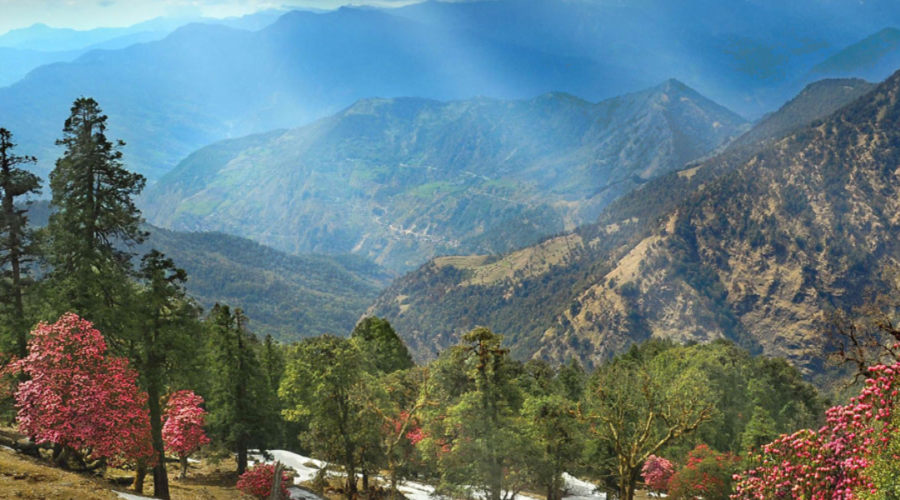Discover the breathtaking beauty of the Himalayas with our Nag Tibba 1 Night/2 Days Trek. This invigorating journey begins with a scenic drive to the quaint village of Pantwari, where trekkers are greeted by stunning vistas of rolling hills and lush forests. As we ascend to the mesmerizing Nag Tibba base camp, situated at an altitude of approximately 9,915 feet, adventurers are treated to panoramic views of snow-capped peaks and picturesque landscapes.
The trek to Nag Tibba summit, standing tall at 9,915 feet, offers a perfect blend of adventure and tranquility. Along the way, trekkers traverse through dense oak and rhododendron forests, encountering vibrant flora and fauna unique to the region. As the golden hues of sunrise illuminate the majestic peaks, trekkers are rewarded with breathtaking panoramic views of the Garhwal Himalayas, including Bandarpoonch, Swargarohini, and Gangotri peaks.
At the summit, trekkers can relish in the sense of accomplishment while soaking in the serene ambiance of the Himalayan wilderness. After spending a memorable night under the starlit sky, surrounded by the majestic peaks, trekkers descend back to Pantwari, carrying cherished memories and a renewed sense of adventure.
Join us on this unforgettable journey to Nag Tibba and experience the magic of the Himalayas like never before!








The best time to undertake the Nag Tibba Trek is in the summer months, from April to June, and the winter months, from October to December. For travelers who would love to experience snow fall or snow trekking, which is in Chopta, the best months to travel to Nag Tibba would be January to March.
In Summers: Summer in Nag Tibba is pleasant and salubrious. The Himalayas can be seen from the distance. There is always a cool breeze blowing to further comfort you. It would be wise to carry light woolens with you in case the night become colder.
In Monsoons: The lush greenery of Nag Tibba is irresistible in the monsoons. There is no better experience than sipping on your cup of tea while gazing at the snow-capped peaks of Nag Tibba while raindrops dance all around you. There could be landslides that result in blocked roads for hours, but still the scenic beauty of Nag Tibba is worth all the trouble. Remember to carry raincoats, of course!
In Winters: If you are looking for serenity and peaceful solitude, you cannot go wrong with the Nag Tibba trek in winters. There will be snowfall during winters, but you can still enjoy the vision of Nag Tibba during winters that is incomparable to anything else. This is what heaven on earth will look like. Winters in Nag Tibba have freezing temperatures so remember to carry heavy woolens.
On the first day of your adventure, the journey commences from Dehradun, the gateway to the Himalayas. From here, a scenic drive takes you to the charming village of Pantwari, serving as the starting point for your trek. As you leave the urban bustle behind and immerse yourself in the tranquil countryside, anticipation builds for the adventures that lie ahead.
The trek officially begins as you set foot on the trail leading to the Nag Tibba Basecamp, nestled at an elevation of 9,900 feet. Meandering through verdant forests and undulating terrain, the route offers glimpses of the rich biodiversity of the region, with sightings of diverse flora and fauna along the way.
As you ascend towards the basecamp, the air grows crisper and the landscape gradually transforms, with panoramic views unfolding around every bend. Upon reaching the Nag Tibba Basecamp, trekkers are greeted by the majestic beauty of the surrounding peaks and the promise of an unforgettable mountain experience.
The first day sets the stage for the adventure ahead, as you settle into the rhythm of the mountains and prepare to conquer Nag Tibba, the abode of the Serpent God, on the following day.
On the second day of the Nag Tibba trek, adventurers embark on a thrilling ascent from the basecamp to the summit point of Nag Tibba, standing proudly at an elevation of 9,915 feet. This leg of the journey promises spectacular vistas and unforgettable moments amidst the rugged beauty of the Himalayas.
Upon reaching the summit, trekkers are rewarded with ample time to soak in the majestic surroundings of Nag Tibba. From this vantage point, panoramic views of the Garhwal Himalayas unfold, offering glimpses of towering peaks such as Bandarpoonch, Swargarohini, and Gangotri.
After spending cherished moments at the summit, trekkers begin their descent back to Dehradun, marking the end of the Nag Tibba trek. As they bid farewell to the mountains, trekkers carry with them memories of a lifetime, along with a sense of accomplishment and rejuvenation from their adventure in the Himalayas.
Yes, it is a perfect trek for the beginners. Trekking at Nagtibba is not difficult can be done easily by first time trekkers.
The best time for Nag Tibba trek is February to Mid-June and Mid-September to end-November. If you want an easy snow trek then last week of December and January are good time.
Medicines: Carry first aid kit, Over the counter medicines and any other medicine which you regularly take.Shoes: Carrry a good trekking shoes, it will help you during the trek.Accessories: Torch, Sunscreen, Hat, water bottle and other necessary itemsClothes: As the temperature is cold throughout the trek with the possibilities of rain, we recommend that you carry woolen clothes, which can be full sleeves woolen sweater, thermal inner wear, windproof jacket, etc. along with a raincoat. A good trekking should will help you during the trek
Nagtibba is good for trekking solo, if you want to do all the trekking on the same day. If you want to stay at the base camp then we recommend that you must go in a group (can be small).
Note: If you are traveling solo then you are responsible for your own safety and therefore it is important that you know the highs and lows well.
Nag Tibba is the highest peak in the lower Himalayas of the Garhwal region. It is situated near Mussoorie of Uttarakhand state. Nag Tibba is situated at an height of 3048 mts above the sea level
+9194597 20589
backinadventure@gmail.com


